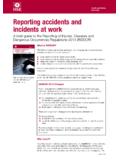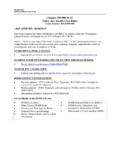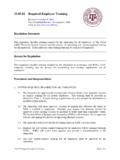Transcription of HSL/2005/36 Literature review on the reporting of ...
1 Harpur Hill Buxton Derbyshire SK17 9JN Telephone: 01298 218000 Facsimile: 01298 218590 Literature review on the reporting of Workplace Injury Trends HSL/2005/36 Project Leader: Christine Daniels Authors: Christine Daniels & Peter Marlow Science Group: Human Factors Crown copyright 2005 PRIVACY MARKING: Available to the public HSL report approval: Dr Rachel O Hara Date of issue: September 2005 Job number: JS2003967 Registry file: RA/RE/2004/22145 Electronic filename: H:\WORK\HSE\REACTIVE\SUPPORT\COMPLETE\CD JS2003967 Underreporting Literature review iii CONTENTS Main findings .. iv Recommendations .. vi 1 Introduction .. 1 Scope .. 1 2 Accuracy of reporting figures within the 2 Background .. 2 Under reporting in the UK .. 2 3 Accuracy of reporting figures in other 4 Fatal accidents.
2 4 Non-fatal 5 4 Accuracy of reporting by industry sector .. 7 Healthcare ..7 Agriculture ..8 Construction .. 8 Voluntary 8 5 Other factors influencing reporting accuracy .. 10 Size of company .. 10 Age .. 10 Type of 10 6 Reasons for under reporting .. 12 Safety incentive programmes .. 12 Safety 14 Workplace violence / bullying .. 17 Problems of using accident data as a performance indicator .. 18 7 Conclusions .. 19 Main findings .. 19 Recommendations .. 21 8 References .. 22 iv EXECUTIVE SUMMARY This document reviews the Literature on reporting patterns for accidents and injuries, focusing particularly on research carried out from 1990 onwards. OBJECTIVES To conduct a review of Literature to: Provide a comprehensive overview of reporting patterns for accidents and injuries; Investigate accident reporting levels by accident type and severity; nature of industry, and size of business; Gain insight into the underlying factors influencing inaccurate reporting such as reporting systems, safety culture, use of incentives and motivation; Look at the reporting patterns for other recordable occurrences ( hospital contamination incidents) MAIN FINDINGS Accuracy of reporting figures On the basis of the research evidence considered, the under reporting of accidents, injures and illness appears to be a worldwide phenomenon, with confirmatory studies conducted in a wide range of countries.
3 As would be expected, trends in accident rates and reporting accuracy vary from country to country, reflecting cultural differences, as well as variation in reporting systems and legislation. Inaccurate reporting by type of company Industry Sector: Comparisons between the Labour Force Survey results and RIDDOR statistics reveal that reporting rates vary significantly by sector. Most notably, reporting accuracy is generally high in the extraction and utility supply sector, yet low within hotels / restaurants and finance / business. A number of studies, primarily from UK or US sources, cited evidence of varying degrees of under reporting of accidents and injuries in agriculture, construction, healthcare and the voluntary sector. Company Size: In both the UK and US, there exists a general consensus amongst researchers that small firms are more likely to under report or not report at all.
4 Explanations offered include a lack of awareness of legal reporting requirements among smaller enterprises, penalties for poor record keeping infrequently levied on small firms, and completing the relevant paperwork posing a greater relative burden for smaller rather than larger firms. Inaccurate reporting by type of injury Musculoskeletal Disorders: Research suggests that the incidence rates for work-related musculoskeletal disorders are heavily under reported. As a result, researchers advocate the need for improved regulatory policy-making and resource allocation for programmatic prevention efforts. v Eye Injury: HSE research indicated a greater propensity to under report eye injuries as opposed to other types of injury site. This may be related to over-3-day injuries (of which a large majority of eye injuries are classed) suffering from significant under reporting .
5 Reasons for under reporting The Literature reviewed identified a number of powerful disincentives to participating in a reporting scheme, for both employers and employees. These are as follows: Safety Incentive Programmes: Safety incentive programmes, which offer rewards for reductions in the number of workplace accidents and incidents, have been widely introduced in industrial settings with the aim of improving safety records and cutting safety-related costs. However, it is evident that limited consensus exists with regard to the efficacy or utility of incentives to improve safety performance in workplace contexts. Some general conclusions may be drawn: Most commentators are in agreement that incentives can improve performance, but that inherent problems may surface as a result of the manner in which they are implemented. It should be appreciated that it a one-size-fits-all approach is unlikely to work, as it is widely postulated that such schemes rarely travel well.
6 Therefore, it is imperative that any incentive scheme allows for flexible implementation. It may tentatively be concluded that incentives do not necessarily lead to perverse motivations ( to under report), although the manner in which incentives are presented, and the methods of performance measurement utilised may potentially affect the likelihood of such adverse consequences. Thus, most criticism has been based on issues of design and implementation rather than principle. Programs based on outcomes, such as reductions in injuries, have drawn greatest condemnation from researchers yet such programs remain popular, largely because they are easy-to-administer and may superficially improve injury statistics. It is generally accepted that the potential for under reporting is greatest when incentives are of a financial nature, possess a high exchange value, or are of the all or nothing variety . Furthermore, in terms of accident reporting , it is widely held that peer pressure can exert a suppressive effect.
7 Safety Culture: It is generally agreed within the Literature reviewed that the under reporting of accidents and incidents is promoted by the presence of a poor safety culture, with inadequate systems in place for reporting dangerous occurrences. One aspect critical to the successful implementation of any reporting scheme is the need for active and visible management commitment to the scheme. Therefore, under reporting is also likely to be symptomatic of poor management commitment to ensuring a safe workplace, as conscientious organisations with a strong managerial commitment to safety make it clear to all employees and supervisors that under reporting of accidents is unacceptable. Research highlighted that under reporting of work-related injuries can also stem from lack of knowledge of reporting requirements, administrative barriers and inadequate reporting mechanisms.
8 More specifically, these unsatisfactory reporting systems are considered by staff to be time-consuming; ineffective in actually stimulating positive change, and often unclear with vi regards to what classifies as a reportable injury. The research suggests that reporting rates may increase if programs are easily accessible, efficient, and confidential. It was also advocated that worker safety training include instruction and encouragement to report workplace injuries. Employee perceptions of reporting : The available research on this topic, albeit limited, suggests a range of factors other than those described above that potentially influence employees willingness to report accidents and injuries. These include fear of reprisal; loss of pay / overtime pay; not wishing to be labelled as a complainer, feeling that suffering from symptoms is a sign of weakness, concerns about privacy and discrimination, and the perception that nothing can be done about the situation.
9 Workplace violence / bullying: The key factors held to induce under reporting of workplace violence and bulling are fear of blame or reprisal, lack of an appropriate reporting system, and employer disinterest. The effects of workplace violence are more acutely observed in certain sectors, with a wealth of research identifying prevalent under reporting in the care and voluntary sector. RECOMMENDATIONS Given the apparently widespread nature of accident under reporting , there appears to be a lack of research targeting the depth and breadth of this problem. More attention has been spent on understanding the causes of this phenomenon, although it may be [tentatively] concluded that these are wide ranging and, to some degree, situation / company specific, making them difficult to effectively target on a national basis. It is recommended that further attempts to identify existing deficiencies in the current occupational safety surveillance and enforcement system be made.
10 To improve reporting levels, there may be scope to take account of current research on incident and near miss reporting , and apply this to the RIDDOR system. For example, it is likely that improvements in the ease of making accident reports, demonstration of positive results as a consequence of proper reporting , and the provision of rapid, useful, accessible and intelligible feedback to the reporting community would be of benefit. Insights from the Literature are limited, or effectively absent, with regard to a number of salient issues. Therefore, on the basis of the gaps identified, the following recommendations for further research are suggested: Studies investigating prevalence of under reporting of eye injuries and work-related musculoskeletal disorders would be useful in order to examine the possible interaction between injury type, injury severity and industry sector on reporting behaviour.














